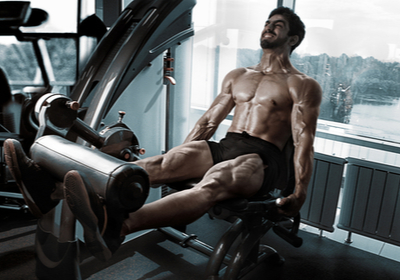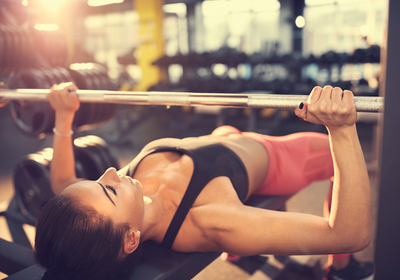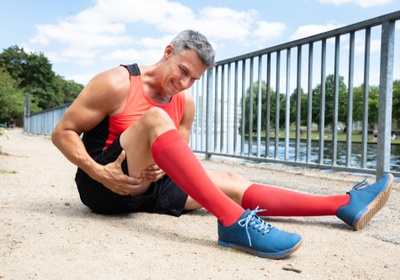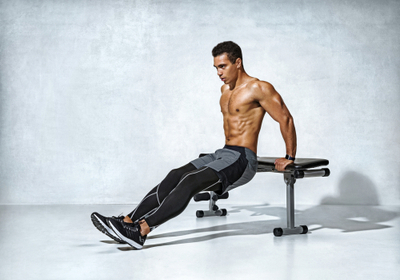VIDEO
Dumbbell Single Leg Romanian Deadlift
- Abs
- Wrists
- Biceps
- Triceps
- Upper Back
- Lower Back
- Shoulders
- Quads
- Hamstrings
- Thighs
- Chest
Level:Advanced
Trainer:Nick Anderson
Equipment:Dumbbell
Dumbbell Single Leg Romanian Deadlift
- Abs
- Wrists
- Biceps
- Triceps
- Upper Back
- Lower Back
- Shoulders
- Quads
- Hamstrings
- Thighs
- Chest
Level:Advanced
Trainer:Nick Anderson
Equipment:Dumbbell
This exercise is going to test your posture, stability. This is a great exercise for hamstrings and lower back. Stay straight with your feet together and the dumbbell in one hand. Leave the left foot down on the floor bending at knee slightly. And start lifting the right foot behind at the same time tilting your body forward. Make the movement slowly and smooth. Make sure that your back is straight the whole time.
save to ...
RECOMMENDED FOR YOU
Split Squat Jump
- Gluteus
- Quads
- Hamstrings
Duaration: 00:29
save to playlist
Vertical Leg Crunches, Bench Jump Over Hands Secured, Double Leg Lifts, Twist Crunches
- Core
- Legs
- Abs
Duaration: 00:15
save to playlist
Burpees
- Arms
- Shoulders
- Quads
Duaration: 00:30
save to playlist
Side Plank, Lunge Pulses, Side Plank Pulses, Squat Jump, Side Glute Raises
- Abs
- Biceps
- Upper Back
Duaration: 00:15
save to playlist
Kettlebell Single Arm Shrugs
- Trapezius
- Upper Back
- Shoulders
Duaration: 00:38
save to playlist
Mountain Climbers
- Core
- Shoulders
- Gluteus
Duaration: 00:30
save to playlist
Deep Squats, Jumping Lunges, Pushups, Reverse Pushups, Elbow Plank Variation
- Core
- Legs
- Abs
Duaration: 00:14
save to playlist
Kettlebell Deadlift
- Core
- Biceps
- Lower Back
Duaration: 00:29
save to playlist
Reclined Figure Four Stretch
- Gluteus
- Hamstrings
Duaration: 00:20
save to playlist
Stair Running, Step Up Hops, Squat Jump
- Lower Back
- Gluteus
- Quads
Duaration: 00:15
save to playlist
Dumbbell Single Arm Renegate Row
- Back
- Biceps
- Triceps
Duaration: 00:33
save to playlist
Plank
- Abs
- Biceps
- Triceps
Duaration: 00:16
save to playlist
Dumbbell Front Shoulder Raises
- Trapezius
- Shoulders
- Chest
Duaration: 00:20
save to playlist
Squat Variation, Pushups
- Core
- Legs
- Biceps
Duaration: 00:15
save to playlist
Barbell Bent Over Row
- Biceps
- Upper Back
- Shoulders
Duaration: 00:45
save to playlist
Gorilla Walks
- Lower Back
- Gluteus
- Quads
Duaration: 00:46
save to playlist
Barbell Standing Tricep Extension
- Core
- Triceps
- Trapezius
Duaration: 00:38
save to playlist
Barbell Skull Crusher
- Triceps
- Upper Back
- Shoulders
Duaration: 00:50
save to playlist
Squat Jumps, Reverse Plank Forward Leg Lifts, Glute Bridge Variation, Reverse Crunches Variation
- Core
- Legs
- Abs
Duaration: 00:15
save to playlist
Bear Crawl Iso Hold
- Core
- Upper Back
- Shoulders
Duaration: 00:38
save to playlist
Elbow Plank Reverse Leg Lifts, Single Leg Bridge, Reverse Leg Lifts
- Core
- Legs
- Abs
Duaration: 00:14
save to playlist
Shoulder Touches
- Biceps
- Trapezius
- Upper Back
Duaration: 00:56
save to playlist
Monkey Bar Travel
- Back
- Biceps
- Triceps
Duaration: 00:15
save to playlist
Plank Knee to Elbow, Elbow to Knee Crunch, Plank Shoulder Touch
- Core
- Arms
- Back
Duaration: 00:15
save to playlist
Side Plank Variation, Pushup Side Plank, Plank Variation
- Biceps
- Upper Back
- Lower Back
Duaration: 00:15
save to playlist
Front Squat Lunge, Standing Glute Kickback
- Lower Back
- Shoulders
- Gluteus
Duaration: 00:15
save to playlist
Sit-Ups
- Abs
- Lower Back
- Obliques
Duaration: 00:44
save to playlist
Switch Back
- Biceps
- Shoulders
- Gluteus
Duaration: 00:15
save to playlist
Low Lunge
- Back
- Lower Back
- Quads
Duaration: 00:15
save to playlist
Squat Jumps, Jumping Lunges, Pushups, Mountain Climbers, Vertical Leg Crunches
- Core
- Legs
- Abs
Duaration: 00:15
save to playlist
Sumo Squat
- Gluteus
- Quads
- Hamstrings
Duaration: 00:23
save to playlist
Elbow Plank with Leg Lift, Elbow Plank Twist, Crunch Twist, Downward Facing Dog, Plank Jump, Scissors
- Core
- Arms
- Legs
Duaration: 00:15
save to playlist
Shoulder Stick Squats, Plank Variation, Fitness ball Knee Tuck, Hip Dips
- Lower Back
- Gluteus
- Quads
Duaration: 00:15
save to playlist
Front Plank to Side Plank, Plank Knee to Elbow, Plank Leg Lifts
- Abs
- Biceps
- Triceps
Duaration: 00:15
save to playlist
Barbell Front Lunge
- Core
- Gluteus
- Quads
Duaration: 00:50
save to playlist
Stair Running, Scissors
- Core
- Biceps
- Triceps
Duaration: 00:15
save to playlist
Pushup Variation
- Core
- Back
- Biceps
Duaration: 00:15
save to playlist
Rock Climbing, Run Up Slide, Pushups, One Hand Pushup, Rope Ladder Climb, Monkey Bars
- Core
- Arms
- Back
Duaration: 00:15
save to playlist
Barbell Shoulder Shrugs
- Core
- Trapezius
- Upper Back
Duaration: 00:31
save to playlist
Reverse Crunches, Pushups Variation
- Abs
- Lower Back
Duaration: 00:15
save to playlist
Blog
The quadriceps is a large and strong muscle that plays the role of the main extensor of the knee joint. Since the knee joint carries the bulk of body weight, the quadriceps is the main muscle of the lower part of the thigh. In fact, if this muscle was weak, people simply would not be able to keep an upright posture. The quadriceps muscle consists of the following parts: straight, internal, external, and middle. Despite this, the load during a variety of exercises falls entirely on this muscle.
Workouts for Quads
Of course, it is very important to strengthen your quadriceps, so let us take a brief look at some of the best exercises for these muscles.
Barbell and dumbbell lungesLunges can be done in different ways - with a barbell, dumbbells, walking around the hall, or from a standing position. Consider options in which the athlete stands in one place, using either a barbell or dumbbells. It is similar to the position when squatting with a barbell on the back. Step forward with your right foot. The lunge should be such that the thigh of the working leg at the lowest point is parallel to the floor. At the same time, the knee of the left leg almost touches the floor and also forms a right angle. Return to the previous position. Swap legs - lunge with your left leg forward.
Leg pressThe leg press eliminates the work of the back and buttocks as much as possible. At the same time, the simulator makes it possible to work with a much higher weight than in squats. In order for the load to fall on the quadriceps, you need to press when setting your feet shoulder-width apart. The execution technique is the following: the back and head are tightly pressed against the back of the simulator, the legs are almost completely straightened and rest against the frame, the hands firmly hold the handles. Bend your knees to form a right angle between your hips and lower legs. Return the legs to the previous position.
One leg squatsCan't go to the gym? Squat on one leg. This is a great exercise for the quadriceps, with which you can load your legs without using additional weights. Start in a standing position, slightly extend one leg forward. Squat down, extending the leg forward and straightening it. Return to the previous position. Do at least 10 repetitions for each leg.
Kick SquatStand with your feet shoulder-width apart and your toes slightly turned to the sides. Place your hands on your belt or hold them near your chest. The emphasis should be on the middle of the foot. Sit down in a horizontal position of your hips, do not forget to keep your back straight. Stand up and shift your weight to one side. Raise your knee to a horizontal position and kick. The kick should go in one motion.
Fitball squatsPlace your feet slightly wider than your shoulders, turn your toes to the sides at 45 degrees. Take the fitball, keep tension and natural deflection in your lower back, your shoulders should be straight as well as your neck. Take a fitball and raise your arms to shoulder level. Along with inhaling, start to bend your knees to the sides, making sure they do not protrude over your toes. At the same time, your buttocks should go down first. The center of gravity lies on your heels. While squatting down, slightly get your back forward, with outstretched arms and raise the fitball above your head. Do 30-50 repetitions.
Final Thoughts
Everyone dreams of beautiful legs and, luckily, getting gorgeous quads is not that difficult at all if you know what you are doing. So why don’t you give these exercises a try?
Read more
While working out most people pay lots of attention to their legs, arms, and abs and quite often they forget about the muscles of their spine, in particular, the lower back. Today, we are going to talk about the health of your lower back as well as how to strengthen these muscles.
Anatomy of Lower Back Muscles
The deep muscles of the back are some of the smallest but strongest muscles that support the spine. Most people mistakenly believe that small is insignificant, but when it comes to these muscles, this is completely wrong. The deep muscles of the back represent a set of muscles that attach to the spine. These muscles are composed of many thick, sinewy bundles that fill the grooves on either side of the spinous processes of the vertebrae and extend from the sacrum to the second cervical vertebra. These muscles spread over 2-4 vertebrae and stabilize the joints at all segmental levels, which allows each vertebra to work more efficiently and reduces the risk of degeneration of the articular structures.
The origin of the deep muscles of the back is the posterior surface of the sacrum, the posterior iliac spines, the mastoid processes of the lumbar vertebrae, and the transverse processes of the thoracic vertebrae. These muscles are attached to the spinous processes of the vertebrae 2-4 segments above the beginning of the muscle.
Exercises for the Lower Back Muscles
In order to keep your lower back strong and healthy, you need to do some simple exercises for this muscle group. So let us take a brief look at those.
Harvesting Apples
Starting in the mountain pose. Raise your hands up and begin to stretch your left hand even higher as if you are trying to reach an apple from a branch above your head. Bend your right knee, pull up your right thigh. Inhale and try to feel the tension in the left square muscle of the lower back. Exhale and relax. Repeat this on the other side. Do 10 repetitions on each side.
Side Stretching
Sit on the floor, resting on your knees, with your hands resting on the floor just below your shoulders. Bring your knees and inner thighs together. Move your hips to the left until you feel comfortable, the left hip is on the bottom, the right is on the top. In this position, look over your right shoulder. Inhale and stretch out along the left lower back and thigh. Exhale, return to the starting position and do the same on the right side. Alternate sides, each time going through the starting position. After doing a few repetitions on each side, you can do the child's pose and rest a little.
Belly Roll
Place a pillow or bolster against your left thigh, then swing your torso towards the pillow. Continuing to stretch in the spine, place your hands on the sides of the pillow and bend over until you touch the pillow with your ribs and chest. Turn your head to the side that is most comfortable for you. Bend your hips and knees until you find a position with a pleasant, light pull on your right side, allowing your right hip to stretch in the opposite direction from your lower ribs. Relax in this position for a few minutes. Then take a few deep breaths and change sides.
Final Word
Developed lower back muscles will help you maintain your back health, which is why you definitely want to work on these muscles. So why don’t you do some of the exercises we mentioned in this article right now?
Read more
Chest muscles are among the hardest ones to train yet strengthening these muscles is totally possible. In this article, we are going to talk about chest muscles and how to train them.
How to Develop Chest Muscles
Developed chest muscles are a vivid indicator of hard work on the body. This muscle group is one of the largest and most complex in the human body. Complete training demands to combine basic and isolating exercises. This is the only way to build the muscles in perfect shape. Barbell exercises are more suitable for increasing muscle mass, and with dumbbells and equipment - for improving the shape and detailed work. It is a bad idea to use really heavyweights in the beginning. It’s much better to learn how to feel the work of the necessary muscles during working out your chest, your arms and shoulders. For example, classic push-ups from the floor will help you feel your chest muscles and understand how they work. For a proper workout, you need to use a variety of dumbbell chest exercises to work the muscles at different angles.
Workouts for Chest
Dumbbell bench pressPlace the dumbbells near your hands. Start by taking the correct position. The back of the head, back and pelvis are pressed to the bench. The heels are pressed into the floor, the legs are separated by 60 degrees. Memorize the position, sit down, grab the dumbbells, and put them on your knees. Lie down while getting the dumbbells to your chest. Extend your arms, leaving a slight angle at the elbow joint, keeping the dumbbells in parallel. Start the chest exercise with a smooth lowering of the weight, moving your elbows to the up and down. When you feel a stretch in your pectoral muscles, return your arms to their original position.
HammerStart it with the right position. Sit on the edge of a bench with the dumbbells on your knees. Lie down tightly pressing the back of your head, back, and lower back to the bench. At the same time, shift your weight from your hips to your chest. Raise your arms in front of you, keeping a 90-degree angle. The palms are turned towards each other, the elbows are slightly bent. Bend your arms as you inhale, bringing the dumbbells to your chest. During the exhalation, unbend focusing on the tension of the pectoral muscles. Repeat it. The Hammer adds extra tension to the triceps, so it's important to focus on your chest muscles. The exercise must be done slowly, and it requires concentrated work. It is great for beginners and athletes recovering from chest, shoulder, or elbow injuries.
Dumbbell PulloverLying on a bench, the back of the head, shoulders and buttocks are kept to the surface, the feet stand firmly on the floor, the hands hold the dumbbells on the chest line with one hand on the other. Fix it and raise the dumbbell over your head, doing a slight bend of the elbow. Exhaling, gently lower the dumbbell behind your head, focusing on stretching the pectoral muscles. Only the shoulders work in the process. Having reached the maximum tension in the lower amplitude, return your arms back along the same trajectory. This exercise with dumbbells on the chest is optional, therefore it is more logical to use it in the mix with basic exercises. It helps to stretch the chest muscles, as well as increase the shape of the chest. Make sure that the head is supported in this position. Otherwise, the risk of straining the cervical muscles or pinching the nerve becomes critical. Work the dumbbell smoothly, avoiding sudden jerks and extreme weights.Also don’t forget that some pre-workout warm-ups are great for increasing your stamina and recovery, but don't rely on them all the time. Getting the right amount of sleep and proper nutrition are two of the most important factors in increasing your gym performance.
Final Thoughts
Exercises for your chest will help you improve your relief as well as general health, so make sure to train these muscles at least a little bit while working out.
Read more
The hamstrings are often underestimated. Usually, training focuses on the quads and calves, but the hamstrings seem to be less important. However, it should be remembered that neglecting any muscle has aesthetic and health consequences that you can avoid by working with it well. The reason you shouldn't forget about these muscles isn't just because of the symmetry and the look of your body. A weak hamstring is one of the most common causes of injuries most professional athletes have.
Best Workouts for Hamstrings
The best way to strengthen your hamstrings is, of course, exercising. So let’s talk about these workouts.
Barbell 90The main benefit of this exercise is that you don't need lots of equipment, just a barbell. Start in a standing position with a barbell on your shoulders, keeping your back straight at all times. Bend your knees slightly, stretch your glutes, and bend forward 90 degrees. Then inhale and return back to the starting position. In addition to the hamstrings, this exercise will also strengthen your glutes and back.
HyperextensionHyperextension is a great exercise for the hamstrings, as well as the muscles in the lower back and glutes. Sit comfortably on the hyperextension machine with your heels firmly resting on the platform at the bottom of the machine. Cross your arms over your chest or behind your head. Smoothly lower yourself down until you feel a stretch in the muscles of the lower back and hamstring while inhaling. Without delay at the bottom point, straighten to the level of the starting position, exhaling. Then return to the starting position. Throughout the exercise, keep your head in line with the body, keep your back straight.
Tights upThis exercise can be performed on two horizontal bars on the playground, or simply put your feet on a chair or bench. We will describe the home workout option.
Sit on the floor with your feet on the chair. Raise the body on your hands so that the tights are up in the air. Bend your knees and lift your tights up so that your body is parallel to the floor. Do 7-8 reps.
One foot and dumbbellsThis exercise works well but requires a nice sense of balance. Take dumbbells in your hands, take one leg back and do not lower it to the floor until the end of the exercise. After that get to the previous position. Repeat this exercise a few times until you are tired.
Final Word
Hamstrings might seem insignificant but it doesn’t mean that you can skip working on these muscles. In fact, strong hamstrings will protect you from many injuries. So do not hesitate and start working on these muscles right now.
Read more
Triceps might seem a little bit important but if you train other muscles and skip triceps exercises, eventually your body will look odd. The thing is you have to gradually develop all the muscles in your body, which is why skipping triceps workouts in favor of biceps exercises is something you want to avoid. So let’s talk about triceps and how to grow it.
Peculiarities of Training Triceps
The triceps are the key muscles in the arms. They account for up to 70% of the mass of the upper limbs, while biceps do about 30%. Moreover, if the biceps is a flexor muscle, which means that it is necessary for lifting weight, the triceps is an extensor. On the one hand, it is easier to develop triceps than other arm muscles due to some anatomical peculiarities. At the same time, the triceps can be easily overloaded, which will have a negative impact on any other exercises that involve the arms, for example, pull-ups and bench press. In other words, when training triceps, it is necessary to separate basic and isolation exercises. For example, you want to work on the pectoral muscles first and do 2-3 targeting exercises for triceps with dumbbells at the end of your workout.
How to Train Triceps?
Despite the fact that some exercises involve a certain part of the triceps to a greater or lesser extent, in the end, the entire triceps works in harmony. Thus, when training the triceps, you have to pay attention to the magnitude of the arm's range of motion as well as avoid trying to engage a specific part of the muscle. In this case, the mobility of the shoulder joint is very important, in fact, it has an impact on how much the muscle is loaded during the exercise.
How Often Should You Exercise?
If you want to build gorgeous triceps, you have to train at least twice a week. The total number of sets in triceps exercises should consist of 4-6 workouts, in other words, 2 exercises in 2-3 sets or 3 exercises in 1-2 sets. The number of repetitions should be about 8-15 repetitions in each set. To increase the efficiency of triceps training, we recommend alternating the load. You might want to start with an easy week and do functional exercises with light weight and high repetitions. Then you can move on to a medium one, then to a hard one, followed by one week of rest.
Workouts for Building Triceps
Finally, let’s have a brief look at some useful exercises that will help you build gorgeous triceps. So here they come:
Close-grip bench press
Lying triceps extension
Cable rope tricep pushdown
Diamond push-ups
One-arm overhead extension
Bench dip
Push-up
45-degree incline dumbbell chest press
Final Thoughts
The triceps is a very important muscle of our arms and, fortunately, it is relatively easy to build. Therefore, if you are dreaming of having gorgeous arms, make sure to start training your triceps muscles.
Read more
SAVE TO ...





